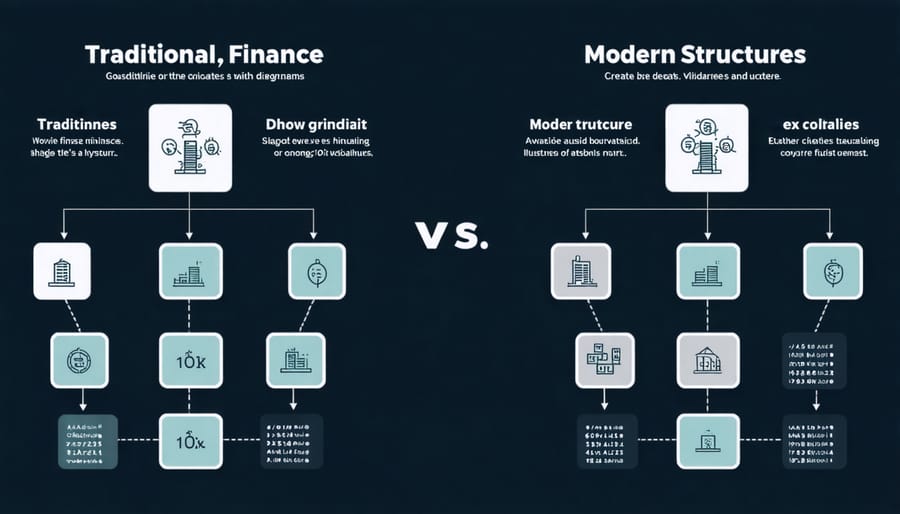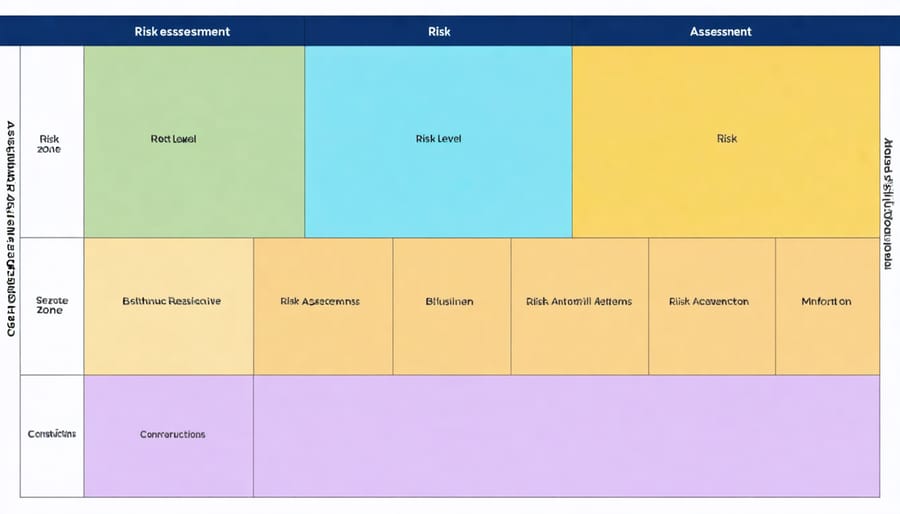In today’s complex construction landscape, project finance models serve as the architectural blueprint for fiscal success, determining not just funding streams but the very viability of multi-million dollar developments. Modern project finance has evolved beyond traditional lending structures into sophisticated frameworks that integrate risk management, sustainability metrics, and innovative funding mechanisms. From public-private partnerships revolutionizing infrastructure development to green bonds reshaping commercial construction, these financial models now fundamentally influence how projects move from concept to completion.
The intersection of technology, environmental considerations, and global capital markets has transformed project finance into a dynamic discipline that demands both technical expertise and strategic foresight. Construction professionals must navigate an increasingly complex web of financing options, each with unique advantages and compliance requirements. Understanding these models isn’t just about securing capital—it’s about optimizing project delivery, managing risk exposure, and ensuring long-term sustainability.
This article explores cutting-edge project finance strategies, examining how industry leaders leverage various funding mechanisms to achieve project objectives while maintaining fiscal responsibility. Through real-world case studies and expert analysis, we’ll dissect the components that make modern project finance models both resilient and adaptable in today’s challenging construction environment.
Traditional vs. Modern Project Finance Structures

Evolution of Construction Finance
Construction project financing has undergone significant transformation since its inception in the mid-20th century. Traditional financing methods, primarily dominated by conventional bank loans and private equity, have evolved into sophisticated modern construction financing approaches that better address complex project requirements.
The 1980s marked a pivotal shift with the introduction of public-private partnerships (PPPs) and structured finance solutions. This evolution accelerated in the 1990s through the emergence of specialized construction lenders and innovative funding mechanisms. Today’s project finance landscape incorporates diverse funding sources, including institutional investors, sovereign wealth funds, and green financing initiatives.
Digital transformation has further revolutionized construction finance, introducing blockchain-based smart contracts, automated compliance monitoring, and real-time financial tracking systems. These technological advancements have improved transparency, reduced risk, and enhanced project delivery efficiency.
Recent trends show increasing adoption of sustainable finance instruments, with green bonds and ESG-linked loans gaining prominence. This shift reflects growing environmental consciousness and regulatory requirements, reshaping how construction projects are funded and executed.
Key Innovation Drivers
Several key factors are driving the evolution of project finance models in today’s construction industry. The increasing complexity of modern construction projects, coupled with rising project costs, has necessitated more sophisticated financing approaches. Risk management requirements have become more stringent, pushing stakeholders to seek innovative funding structures that better distribute project risks.
Technological advancement plays a crucial role, with digital platforms enabling more efficient financial tracking and management. The rise of sustainable construction practices has also introduced new financing mechanisms, including green bonds and sustainability-linked loans, which offer preferential terms for environmentally conscious projects.
Market demands for faster project delivery and greater cost certainty have spurred the adoption of alternative financing methods. Public-private partnerships have gained prominence, particularly in infrastructure projects, as governments seek to leverage private sector expertise and capital. Additionally, the globalization of construction markets has introduced international funding sources and cross-border financing solutions.
Economic volatility and changing regulatory landscapes continue to shape how projects are financed, leading to more flexible and resilient funding structures that can adapt to market conditions while maintaining project viability.
Contemporary Project Finance Models
Public-Private Partnerships (P3)
Public-Private Partnerships (P3s) represent a sophisticated collaboration model where government entities and private sector companies share resources, risks, and rewards in large-scale construction projects. This financing approach has gained significant traction in infrastructure development, particularly in transportation, healthcare facilities, and educational institutions.
In a typical P3 arrangement, the private sector partner provides upfront capital investment and assumes responsibility for design, construction, operation, and maintenance. The public sector maintains ownership while establishing performance standards and regulatory oversight. This structure allows governments to leverage private sector expertise and financial resources while maintaining public interest protection.
Key benefits of P3s include risk transfer, accelerated project delivery, and lifecycle cost optimization. Private partners, motivated by long-term revenue streams, often implement innovative solutions and efficient management practices. However, successful P3 implementation requires careful consideration of factors such as risk allocation, contract structure, and stakeholder alignment.
Recent industry data indicates that P3 projects typically achieve 15-20% cost savings compared to traditional procurement methods. Notable examples include the Port of Miami Tunnel project, which demonstrated superior risk management and on-time delivery through effective P3 structuring.
Critical success factors for P3s include:
– Transparent procurement processes
– Clear performance metrics
– Equitable risk distribution
– Strong legal and regulatory frameworks
– Effective stakeholder communication
– Long-term financial viability assessment
For construction professionals, understanding P3 dynamics is crucial as this model continues to shape major infrastructure development globally.
Green Finance Instruments
The construction industry’s shift toward sustainability has led to the emergence of innovative green financing solutions designed specifically for environmentally conscious projects. These instruments include green bonds, which fund projects with clear environmental benefits, and sustainability-linked loans that offer favorable terms based on achieving specific environmental targets.
Environmental, Social, and Governance (ESG) criteria now play a crucial role in project financing decisions. Lenders increasingly evaluate projects based on their carbon footprint, energy efficiency measures, and overall environmental impact. This has given rise to specialized financial products such as energy performance contracts and green mortgages, which provide preferential rates for buildings meeting specific sustainability standards.
Carbon credit financing has emerged as another vital instrument, allowing projects to monetize their environmental benefits through carbon offset markets. Additionally, green infrastructure funds specifically target projects incorporating renewable energy systems, water conservation measures, and sustainable building materials.
Many jurisdictions now offer tax incentives and grants for sustainable construction projects, making green finance instruments more attractive to developers and investors. These mechanisms, combined with increasing regulatory pressure and market demand for sustainable buildings, have transformed how construction projects are financed and executed.
Blockchain-Based Financing
Blockchain technology is revolutionizing project finance in the construction industry by introducing transparent, secure, and efficient methods of managing financial transactions. This distributed ledger system creates an immutable record of all financial activities, enabling stakeholders to track funding, payments, and contract execution in real-time.
Smart contracts, a key feature of blockchain technology, automate payment releases based on predefined project milestones. This automation reduces payment delays and disputes while ensuring contractors and suppliers receive compensation promptly upon meeting contractual obligations. For instance, when a structural phase is completed and verified, the smart contract automatically triggers the associated payment without manual intervention.
Several major construction firms have implemented blockchain-based financing solutions to streamline their project funding. These systems facilitate faster processing of supply chain financing, reduce documentation requirements, and minimize intermediary costs. The technology also enables the tokenization of construction assets, allowing for fractional ownership and increased liquidity in project financing.
Security features inherent in blockchain technology protect against fraud and unauthorized modifications of financial records. Each transaction is cryptographically secured and verified by multiple nodes in the network, creating a trustworthy environment for all stakeholders. This enhanced security has proven particularly valuable in international construction projects where multiple parties and currencies are involved.
Recent industry reports indicate that construction companies utilizing blockchain-based financing have reduced their transaction costs by up to 25% and decreased payment processing times by up to 75%.

Crowdfunding and Alternative Investment
The construction industry is witnessing a significant transformation in project financing through innovative alternative funding methods, particularly in crowdfunding and specialized investment platforms. These emerging solutions enable projects to access capital from diverse sources while distributing risk across multiple stakeholders.
Digital platforms now facilitate direct investment from multiple parties, allowing smaller investors to participate in large-scale construction projects. For instance, real estate crowdfunding platforms have successfully funded numerous commercial developments, with some projects raising over $50 million through collective investment approaches.
Construction-specific investment platforms are emerging as specialized intermediaries, offering detailed project analytics and risk assessment tools to potential investors. These platforms typically implement rigorous due diligence processes and provide transparent project monitoring systems, enhancing investor confidence and project accountability.
The integration of blockchain technology and smart contracts has further revolutionized alternative investment in construction projects. These innovations enable automated payment distributions, real-time progress tracking, and enhanced security for investors. Several major developers have already implemented blockchain-based funding platforms, reporting increased efficiency in capital deployment and reduced administrative costs.
For project managers and developers, these platforms offer advantages beyond traditional financing, including faster capital access, flexible funding structures, and reduced dependency on conventional lending institutions. However, careful consideration of regulatory compliance and investor protection measures remains crucial for successful implementation.
Risk Management and Structuring
Financial Risk Assessment
Effective construction financial risk management is crucial for project success and requires a systematic approach to identification, assessment, and mitigation of potential financial threats. Key risk factors typically include interest rate fluctuations, currency exchange volatility, credit risk, and market conditions that could impact project viability.
Project finance professionals employ various analytical tools to evaluate these risks, including sensitivity analysis, Monte Carlo simulation, and stress testing. These methods help quantify potential impacts on project cash flows and determine appropriate risk mitigation strategies. Value at Risk (VaR) calculations are particularly useful for assessing potential losses under different scenarios.
Risk mitigation strategies often involve a combination of financial instruments and contractual arrangements. Common approaches include:
– Interest rate swaps and hedging instruments to manage rate fluctuations
– Performance bonds and guarantees to protect against counterparty defaults
– Insurance coverage for specific project risks
– Contingency reserves built into financial models
– Step-in rights for lenders in case of project distress
Regular monitoring and updating of risk assessments throughout the project lifecycle is essential. This includes tracking key performance indicators, maintaining risk registers, and implementing early warning systems for potential issues. Successful projects typically establish clear protocols for risk reporting and escalation procedures when predetermined thresholds are breached.
Modern risk assessment frameworks increasingly incorporate digital tools and real-time data analytics to provide more accurate and timely risk insights, enabling proactive rather than reactive risk management approaches.

Legal and Compliance Framework
Project finance models must operate within a complex framework of legal and regulatory requirements that vary by jurisdiction and project type. Construction professionals need to navigate multiple compliance layers, including environmental regulations, building codes, financial disclosure requirements, and contractual obligations.
Key regulatory considerations include securities laws for project funding, environmental impact assessments, and construction permits. Projects often require compliance with national and local building standards, zoning regulations, and safety requirements. Additionally, international projects must address cross-border regulations and currency exchange laws.
Risk management protocols typically mandate comprehensive insurance coverage, including construction all-risk policies, professional liability insurance, and performance bonds. Project sponsors must also ensure compliance with anti-corruption laws, particularly for publicly funded projects or those involving multiple jurisdictions.
Documentation requirements are extensive, encompassing detailed financial models, environmental impact studies, and legal agreements between stakeholders. These documents must meet strict regulatory standards and often require independent verification by qualified professionals.
Modern project finance structures increasingly incorporate ESG (Environmental, Social, and Governance) compliance requirements, reflecting growing investor emphasis on sustainable development. This includes adherence to green building standards, social impact assessments, and transparent governance frameworks.
Regular compliance audits and reporting mechanisms are essential to maintain regulatory alignment throughout the project lifecycle, with particular attention to financial covenants, construction milestones, and environmental commitments.
Case Study Analysis
The Dubai Metro Red Line extension project exemplifies successful project finance implementation, utilizing a public-private partnership (PPP) model that secured $3.2 billion in funding. The project combined government guarantees with private sector investment, resulting in timely completion and efficient risk allocation among stakeholders.
Another notable example is the London Olympic Village development for the 2012 Games. When private funding became challenging during the 2008 financial crisis, the project adapted its financing structure to include public sector intervention and institutional investors. This flexibility ensured project completion while maintaining commercial viability.
The Toronto Crosstown Light Rail Transit project demonstrates innovative project finance application in North America. The CAD $5.3 billion initiative employed a design-build-finance-maintain model, with the Ontario government partnering with private consortiums. The financial structure included both government backing and private sector performance guarantees, creating a balanced risk profile.
In emerging markets, the Bangalore International Airport showcases how project finance can facilitate large-scale infrastructure development. The project utilized a mix of equity contributions from private sponsors, debt from domestic banks, and strategic investment from international financial institutions. This diversified funding approach helped mitigate country-specific risks while ensuring project sustainability.
These cases highlight the importance of adaptable financing structures, robust risk management, and strategic stakeholder alignment in successful project finance implementations.
Project finance models continue to evolve as the construction industry faces new challenges and opportunities. The successful implementation of these financing structures depends on thorough risk assessment, strategic partnership development, and innovative funding mechanisms. As we look ahead, sustainability-linked financing and digital technologies are expected to play increasingly important roles in project finance solutions. The integration of ESG criteria and the rise of hybrid financing models suggest a more flexible and environmentally conscious approach to construction project funding. Industry leaders who adapt to these emerging trends while maintaining solid financial fundamentals will be better positioned to secure funding and deliver successful projects in an increasingly competitive market. The future of project finance will likely see greater emphasis on adaptable structures that can accommodate both traditional and alternative funding sources, ensuring project viability across various market conditions.

